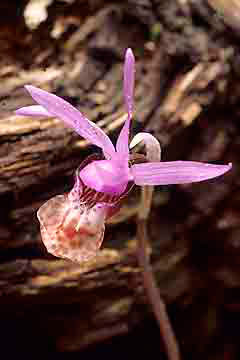 |
Fairy-slipper, Calypso bulbosa
(L.) Oakes var. occidentalis (Holz.) B. Boivin
(left) is one of the most colorful of our orchids. It is not a rare plant,
but it is elusive, for it grows amid the moist litter of evergreen forests
where it blooms in late spring. So far as we are aware, it is not found south
of the Clearwater River drainage in Idaho. Lewis and Clark—most
likelyMeriwether Lewis—discovered this then new-to-science plant blooming
along the Lolo Trail and collected one as a specimen on June 16, 1806. The
plant shown here was photographed in the DeVoto Grove, west of the Lolo Pass,
close to where the explorers found theirs. Another variety, var.
americana (R. Br.) Luer occurs (rarely) in Idaho.
Mountain lady’s-slipper, Cypripedium
montanum Douglas ex Lindl.
(right) bears flowers that are smaller and more numerous
than those of other species of Cypripedium; still, with its showy
white blooms it, too, is an elegant plant. Two other lady’s slippers
are native to Idaho. The one shown here is the most common of the
three—finding one will make a hiker’s day. Meriwether Lewis encountered
the mountain lady’s-slipper on the Lolo Trail and again at Traveler’s
Rest, near today’s Missoula, Montana on July 1, 1806. We do not know
whether he gathered a specimen; if so, it did not survive the homeward journey.
|
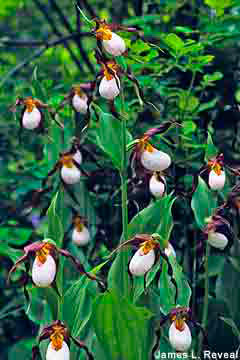 |
 |
Spotted coral-root, Corallorhiza
maculata (Raf.) Raf. var. occidentalis (Lindl.)
Ames (left, right). Coral roots are saprophytes. The flowers
shown here— magnified considerably—are those of a fairly common
species that grows in open shade of forests where the plant's slender,
reddish-brown stems stand out. The flowers with their spotted white lips
are striking, but you will need a hand lens to see them well, true of many
of our native orchids. Another variety, var. maculata, also occurs
in Idaho. It is a similar plant, with a narrower flower lip. Another, very
similar species, Corallorhiza striata Lindl. with striped flowers,
is also found in Idaho |
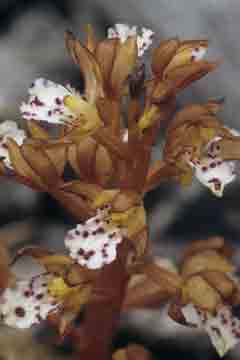 |
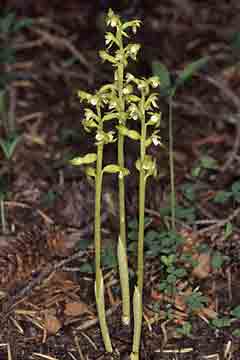 |
Yellow coral-root, Corallorhiza
trifida
Châtelaine (left, right). Coral-roots—named
for the bright red color of their root systems—lack chlorophyll. Their
“leaves” are represented by sheathing bracts seen on the lower
part of the stems. The color of coral-roots ranges from the reddish-brown
of the spotted coral-root shown above, to the yellowish color of this plant.
This plant's species name, trifida, means three-lobed, describing
the irregular end of the flower’s lip. This plant, like the spotted
coral root, is widely distributed all across northern North America. |
 |
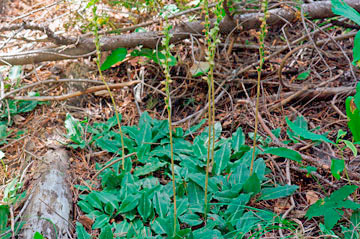 |
Western rattlesnake plantain, Goodyera
oblongifolia
Raf. (left, right) catches the eye only because its
several, deep-green, basal leaves are mottled with a central white stripe;
it is otherwise a plain little plant. The name “rattlesnake plantain,”
comes from a fancied resemblance of the leaves’ markings to those of
rattlesnakes. Small white flowers (greatly magnified here) form a loose cluster
at the top of the plant's stem; then, later in the summer one sees only
the basal leaves and a dried stem. Interestingly, because the pedicels (stemlets)
are twisted, the plant’s flowers are upside-down (“resupinate”)
and a sepal fused with two petals forms a “hood.” Look for this
little orchid in shaded woods. The generic name Goodyera honors English
botanist, John Goodyer (1592-1664). |
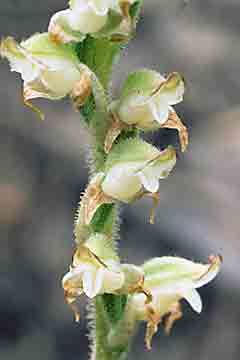 |
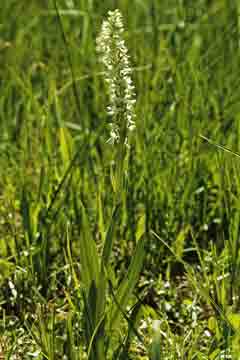 |
White bog orchid, Platanthera
dilatata, (Pursh) Lindl. ex L. C. Beck var.
dilatata (left, right) has
several names: “rein orchid,” (for the strap-like lower lip),
“boreal orchid,” and “habenaria” (a former generic
name). There are several varieties, distinguished by slight differences;
the one shown here is the most common variety. It is a meadow plant and our
most common orchid, often found growing above treeline. Its flowers, like
those of Goodyera, are resupinate. A ventral lip, two sepals extending
laterally, and a “hood” made up of a dorsal sepal and petals are
family characteristics (shown here greatly magnified). A prominent
downward-curving spur confirms the species’ identification. The name
Platanthera, from the Greek, means “wide (or flat) anther”;
dilatata, from the Latin means “broad” or
“wide,” apparently referring to the lip’s wide base.
|
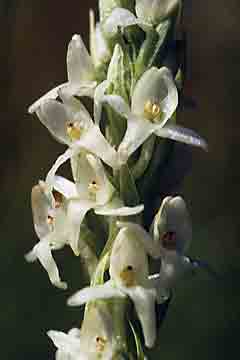 |
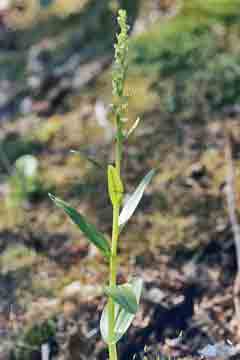 |
Slender bog orchid, Platanthera
stricta Lindl. (left, right).
The slender bog orchid (formerly Habenaria saccata Greene), while
not uncommon, is less often encountered than the plant shown above. As its
former classification saccata suggests, it is characterized by a swollen,
sac-like “scrotiform” spur that hangs down behind the flower, an
identifying characteristic. The species name, stricta, means
“straight.” Lindley, who described the plant, apparently used
stricta to refer to the narrow flower cluster. |
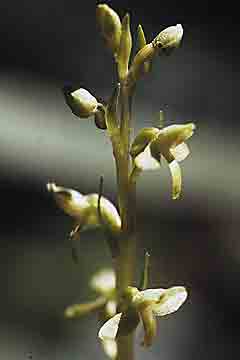 |
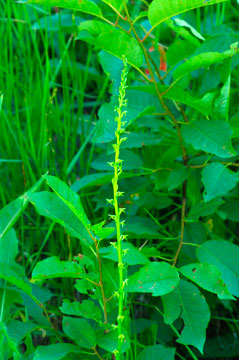 |
White-lip (or Alaska) rein-orchid, Piperia
unalascensis (Spreng.) Rydb.
(left, right). The Alaska rein-orchid was until recently
classified as a Habenaria (Platanthera). Although similar to
habenarias, it is different enough to classify it as originally published,
in genus Piperia. The plant is notable for its height--it is among
the tallest of our orchids.. Its spike-like stem, arising from a rosette
of two or more parallel veined leaves, is studded along its upper part
by tiny white flowers that somewhat resemble the plants in genus
Platanthera. Our plant's height and overall appearance make identification
easy. The generic name, Piperia, honors America botanist Charles Vancouver
Piper (1867-1926). |
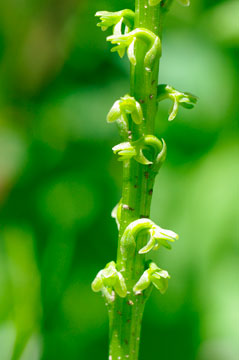 |
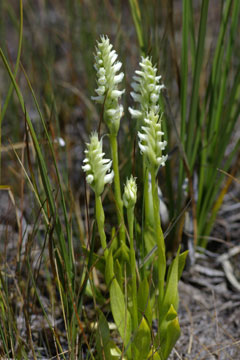 |
Hooded ladies’-tresses,
Spiranthes romanzoffiana Cham.
(left, right) are found all across the North American
continent and even in the British Isles. In our area the plant grows to treeline
and higher. Its stemless flowers are borne on a stout spike-like stem. Each
flower is offset a few degrees from the one below, forming the spiral that
gives the plant its generic name. The petals (except for the ventral lip)
join to form a hood. Spiranthes is derived from two Greek words,
speira meaning “coil” or “spiral” and
anthos for “flower.” The species name honors Nicolai von
Romanzov (1734-1826), the Grand Chancellor of the Russian Empire, who
sponsored—and funded—the around-the-world expedition led by explorer
Otto von Kotzebue (1787-1846) in the years 1815-1818. |
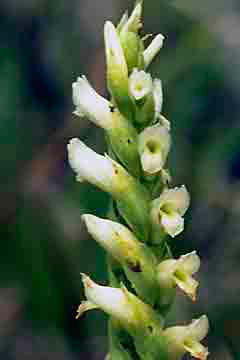 |















